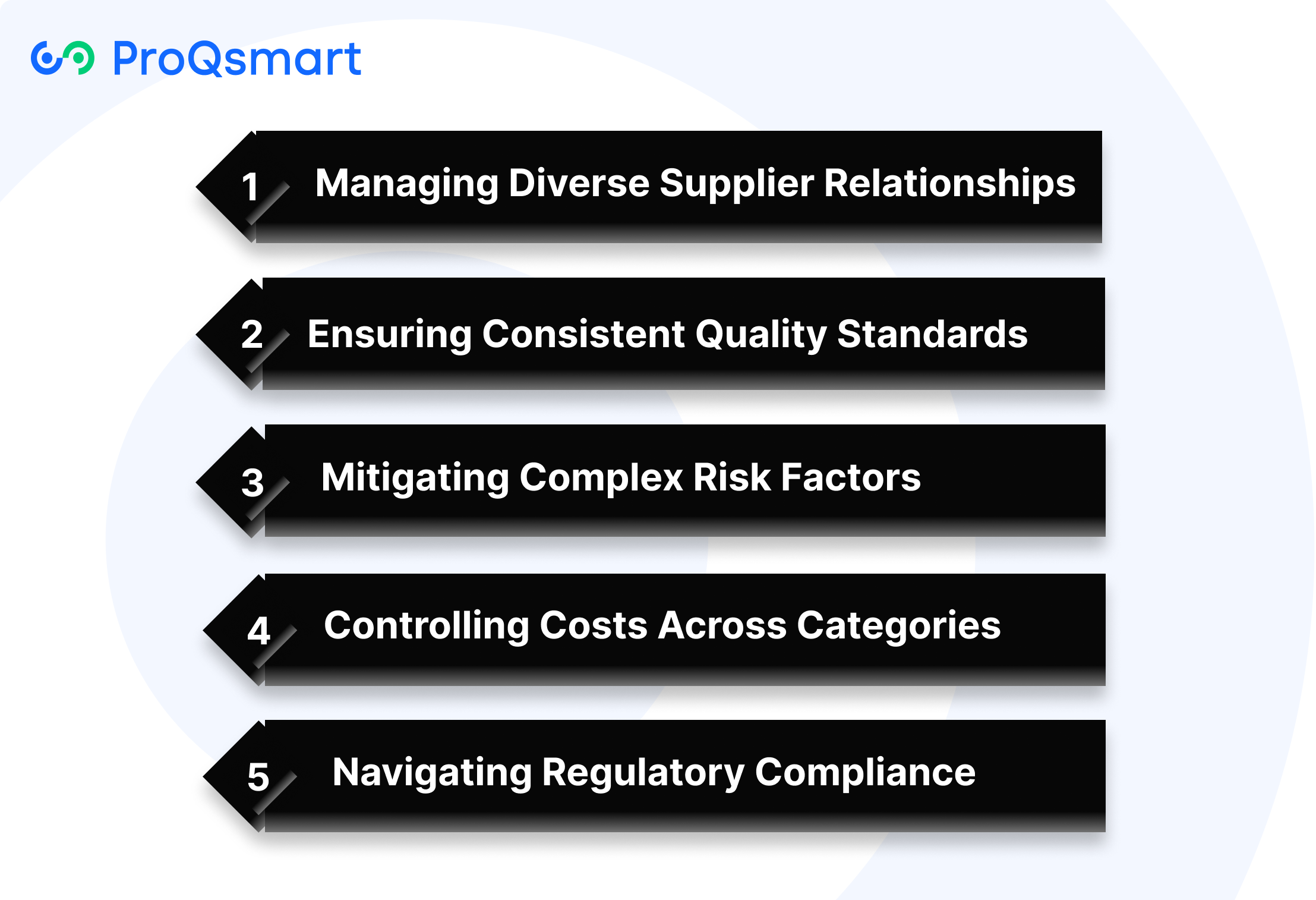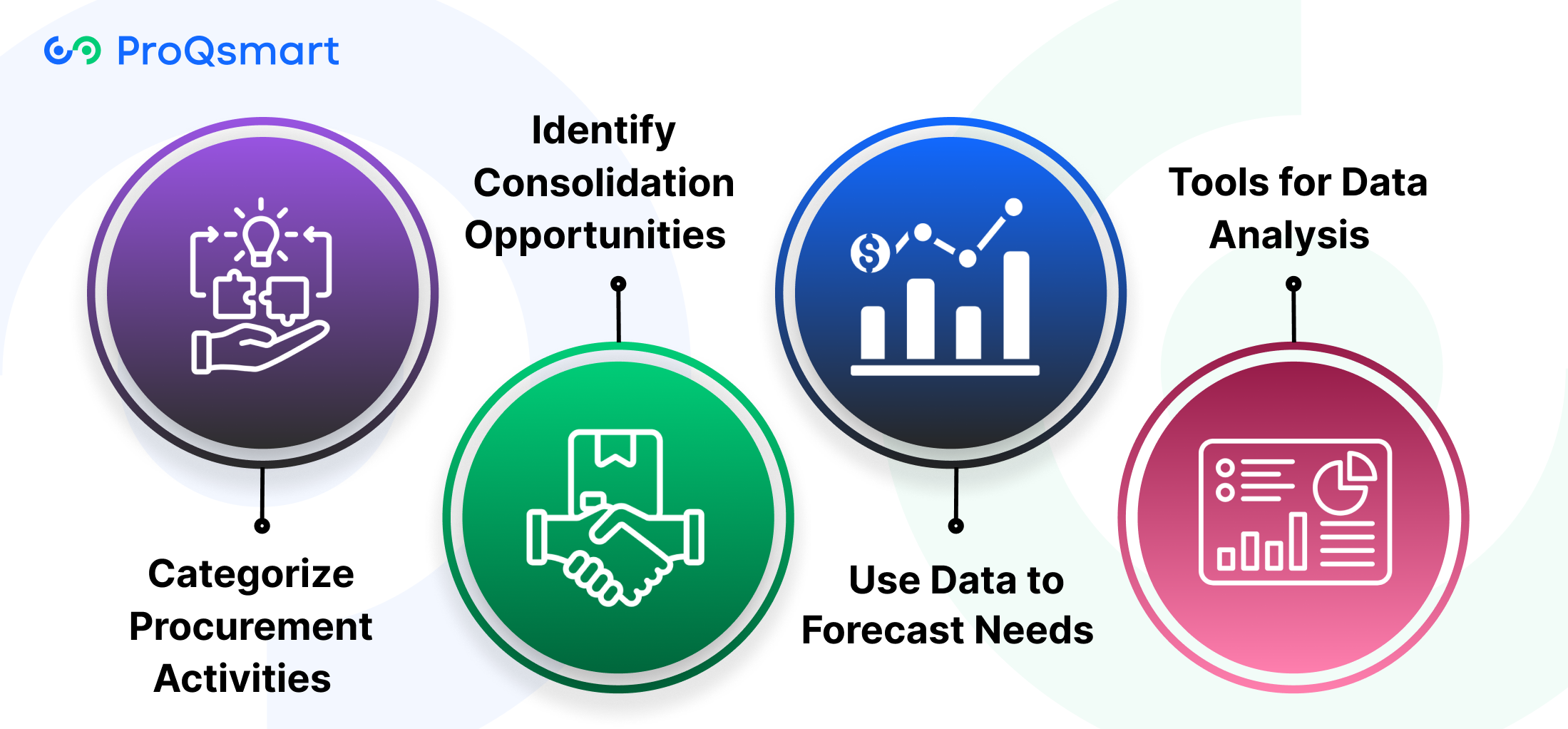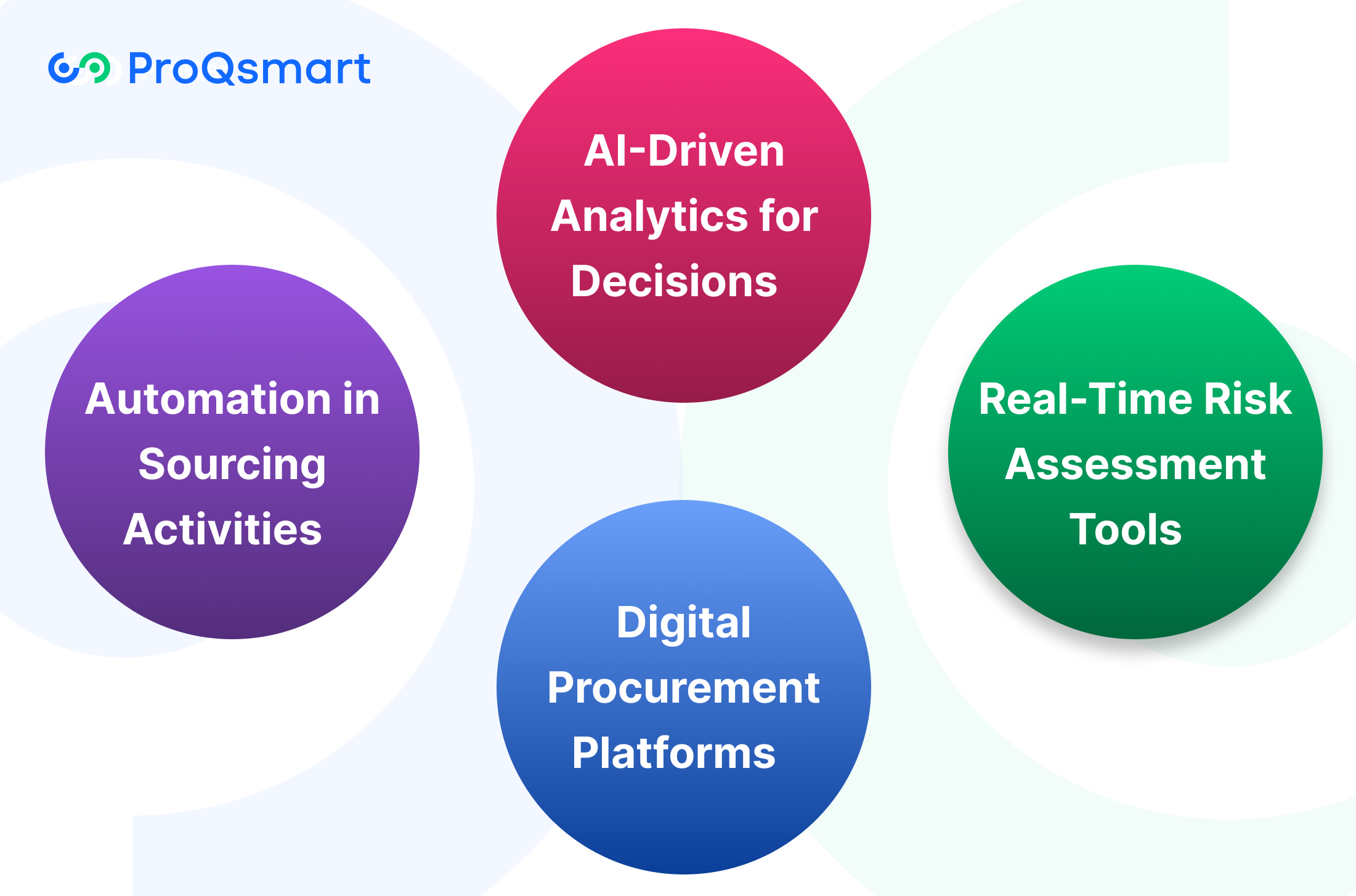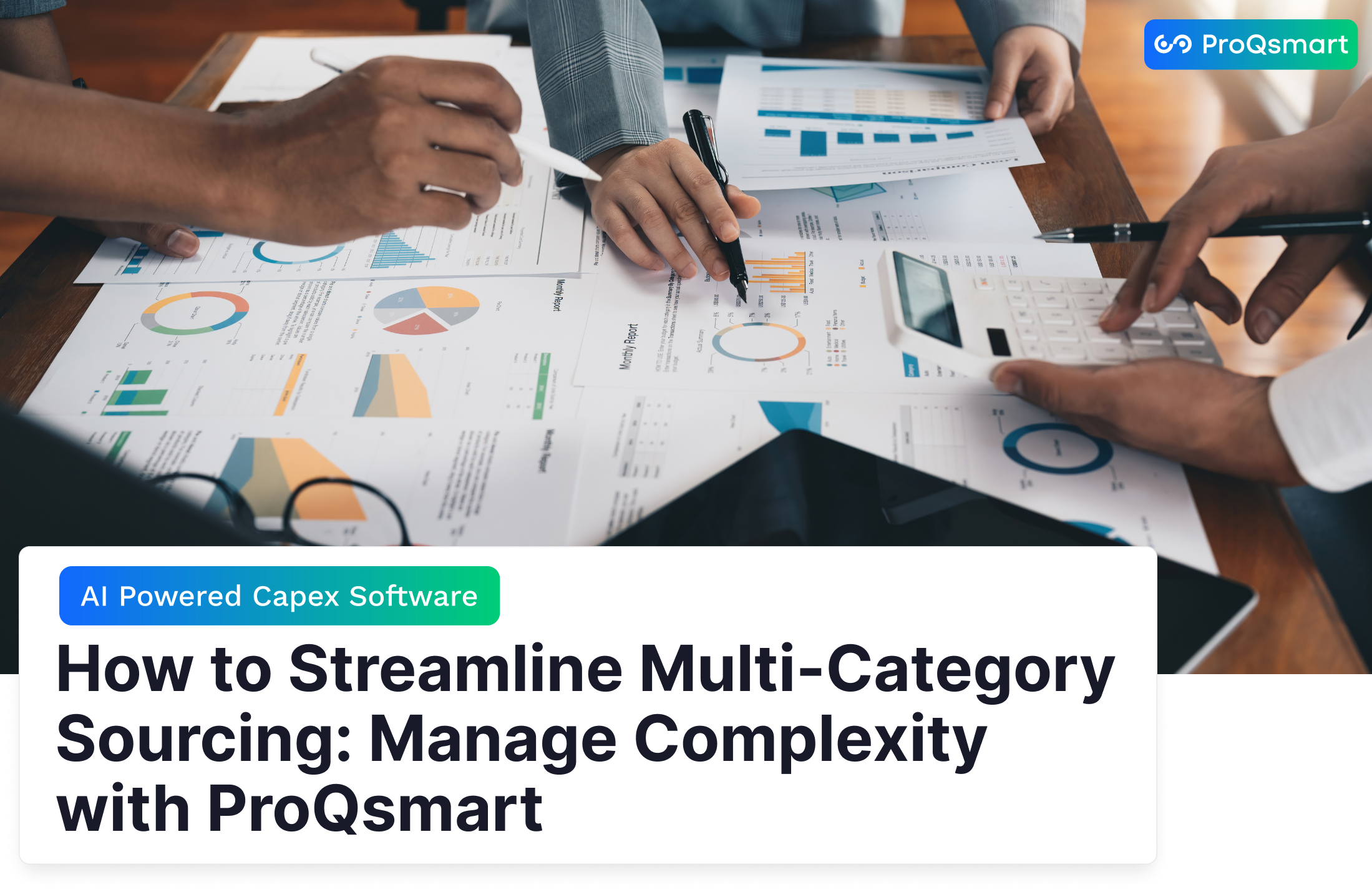Sourcing is the strategic process of identifying, evaluating, and securing suppliers to meet an organization’s procurement needs. It focuses on selecting reliable vendors, negotiating favorable terms, and ensuring consistent quality and timely delivery of goods or services.
Effective sourcing not only reduces costs but strengthens supplier relationships and drives operational efficiency. By integrating market research, risk assessment, and technological tools, sourcing becomes a critical function in achieving business goals.
For professionals in procurement, mastering sourcing strategies can lead to long-term value and sustainability. In this blog, we’ll explore actionable insights, proven techniques, and industry trends to help you optimize your sourcing processes and stay ahead in the competitive procurement landscape.
What is Multi-Category Sourcing?
Multi-category sourcing is an advanced procurement strategy that consolidates the management of multiple categories of products or services across several suppliers. This method helps to make sure that procurement activity is spread purposefully across various needs and promotes both supplier diversity and competition.
Companies can gain more agility by using multi-category sourcing. With this approach, they gain flexibility to meet evolving demand, lessen dependence on key suppliers, and drive greater supply chain efficiency across the board.
Key Elements of Sourcing Process
A strong sourcing process is key to navigating the added complexity that comes along with multi-category sourcing. It all starts with supplier selection. Rate them based on their capacity, reliability and fit with your operational objectives.
This phase further consists of contract negotiation, emphasizing beneficial provisions and enduring contracts. A clear and guided approach is crucial when tackling the complexities of multi-category sourcing, maintaining flexibility while reducing disruptions.
Key components in the sourcing process include:
- Supplier evaluation: Regular assessment of suppliers’ performance and capabilities.
- Order of extensive examination of pricing categories to uncover potential savings.
- Identification and mitigation of risks, from delays to compliance issues.
In highly regulated industries such as aerospace, dual/multi-sourcing ensures continued access to specialized, high-quality components. This approach further avoids reliance on one vendor.
ProQsmart supports businesses in this process by integrating AI-driven tools for real-time collaboration, supplier performance monitoring, and automated workflows. This alignment helps to ensure procurement efforts are in line with strategic goals like cost-saving and compliance.

Challenges in Multi-Category Sourcing

Effective multi-category sourcing is key to a successful sourcing strategy. The reality is that managing a wide variety of products presents its own set of challenges that require careful, creative solutions. From supplier relationship management to regulatory compliance, procurement teams must navigate numerous supply chain activities to maintain operational efficiency and cost-effectiveness.
1. Managing Diverse Supplier Relationships
Coordinating relationships with multiple suppliers is a daunting task. On top of that, every supplier is going to have their own process, timeline, and expectations, making communication and management a challenge. Building trust and ensuring continued alignment is key, and strong collaboration and transparency are critical toward that goal.
For example, routine relationship building, quarterly performance reviews, and so on can strengthen accountability. Best practices include:
-
Establishing clear communication protocols
-
Conducting quarterly performance evaluations
-
Leveraging solutions such as ProQsmart for supplier performance tracking and enabling collaborative environments in real-time
2. Ensuring Consistent Quality Standards
Quality control across product categories is key. Different suppliers might have very different standards, creating a lack of consistency. Implementing standardized metrics to evaluate supplier performance ensures alignment with organizational goals.
ProQsmart’s automated workflowsand data transparency simplify quality monitoring, reducing manual oversight while ensuring compliance.
3. Mitigating Complex Risk Factors
The emphasis on single or limited-country sourcing has been exacerbated by disruptions from around the globe. One of the benefits of multi-category sourcing is lowering dependency, spreading the risk over several suppliers.
Strategies such as scenario planning and contingency contracts proactively protect against bottleneck creation. ProQsmart’s AI-driven insights help cities spot vulnerabilities and plan in advance.
4. Controlling Costs Across Categories
Cost management is critical. Agreements such as bulk purchasing and long-term contracts are effective for cost control. With ProQsmart’s budget-driven procurement, you can track spending in real time.
This ensures you’re always on the same page as your financial goals.
5. Navigating Regulatory Compliance
Regulatory compliance is inconsistent across product lines. A compliance checklist is a way to make sure you’re meeting all the legal requirements.
ProQsmart’s auditable sourcing data makes compliance simple, saving time, reducing risk, and increasing transparency along the way.
Benefits of Streamlining Sourcing
The benefits of streamlining sourcing are real, benefiting operations with more efficiency, improving supplier engagement and collaboration, and providing quantifiable cost reductions. In today’s rapid-paced business environment, efficiency is not just preferred—it’s absolutely necessary.
By prioritizing the optimization of their sourcing strategies, organizations are more equipped to respond to fast-paced and ever-changing markets, scale their businesses efficiently, and drive sustainable growth.
Centralized Procurement Advantages
Having one primary hub for your procurement processes creates uniformity and boosts overall efficiency when sourcing across various categories. It centralizes all purchasing activity, eliminating redundancies and allowing your team to negotiate down from strength.
Streamlined sourcing dramatically improves negotiation power, resulting in direct cost reductions from 7-15% of what companies currently spend on procurement. From improved compliance to increased visibility, centralization makes it easier than ever to take the reins.
Key advantages include:
-
Unified processes across departments
-
Streamlined workflows and reduced errors
-
Improved supplier performance monitoring
Enhanced Supplier Collaboration Value
Creating deep, collaborative relationships with suppliers helps to breed innovation to meet project needs and guarantee reliable delivery of services. With better collaboration, suppliers will be able to align with your needs with greater accuracy, producing better results.
Partnerships that are built on strategies including regular performance reviews and real-time communication and accountability via a platform like ProQsmart make for effective and resilient partnerships.
Improved Spending Visibility
Improved spending visibility is essential for an effective sourcing strategy in procurement management. Techniques to achieve this include automated expense tracking, which streamlines the supply chain management process and reduces manual errors. Additionally, comprehensive spend analysis provides valuable insights into spending patterns, helping organizations identify areas for cost savings. By leveraging these techniques, businesses can enhance their understanding of financial flows and make informed decisions. Ultimately, improved visibility leads to better budget control and more strategic procurement practices.
Standardized Practices for Risk Reduction
Having standardized procedures and policies in place protects your company from risk while ensuring your suppliers keep pace. A risk management framework, like ProQsmart’s automated workflows, feeds rubrics with objective standards.
This rigorously collaborative approach improves supplier performance and lowers risk.

Strategies to Improve Sourcing
Making better sourcing decisions is an exercise in data-driven decision making and strategic supplier management, paired with ongoing adaptation. Sourcing strategies have always been important, but in today’s unpredictable market, they are more critical than ever.
They’re your funnel to cost savings, operational efficiency and long-term partnerships with your suppliers. Here are five concrete strategies that can help improve multi-category sourcing.
Conduct Detailed Spend Analysis
An effective spend analysis is your first step in surfacing procurement trends and spotting potential areas where you can save money. By tapping into historical data, you’ll be able to combine purchases and negotiate favorable terms in your suppliers.
Steps for effective spend analysis include:
-
Collecting procurement data from all categories.
-
Categorizing expenses to identify high-spend areas.
-
Pinpointing consolidation opportunities to reduce fragmentation.
Consolidate Supplier Base Strategically
Less fragmentation among suppliers leads to more efficiency and better relationship-building opportunities. Consolidating suppliers into similar categories allows for the negotiation of long-term contracts with fewer suppliers, potentially leading to improved pricing and quality assurance.
So, before consolidation, it’s essential to evaluate supplier capabilities to make sure they can deliver the best fit to support your organization’s goals.
Integrate Technology for Automation
Innovative technological solutions such as ProQsmart further transform the way organizations source by automating and accelerating workflows, improving collaboration, and delivering transparency.
ProQsmart’s AI-driven tools make it easy to manage complex documents, maximize supplier performance and ensure procurement teams align with budgetary requirements. In addition to reducing procurement cycles, e-sourcing platforms allow for real-time decision-making.
Foster Cross-Functional Collaboration
To help best align with business objectives, collaboration between procurement, finance, and operations is crucial for successful sourcing. Aligned goals and strategic sourcing principles create more productive synergy, enabling better sourcing decisions.
Implement Performance Monitoring System
Frequent supplier performance reviews ensure accountability and a focus on quality suppliers. By creating clear key performance indicators (KPIs), such as delivery timelines and compliance rates, you can establish a successful sourcing strategy to effectively monitor supplier performance.
How to Conduct Spend Analysis for Effective Sourcing

Spend analysis is the foundation of effective sourcing strategies. It can reveal their inefficiencies, reveal their cost-saving opportunities, and improve procurement practices. With a thoughtful approach to analyzing spend, you’ll create a foundation for better decision-making and more meaningful outcomes.
Read on as we explore some of the important steps and considerations necessary for conducting a spend analysis that drives effective sourcing.
Categorize Procurement Activities
Without accurate categorization of procurement activities there’s no chance of driving actionable insights. Organize your spend based on factors like type of supplier, category of product, or how often you spend. This method will allow you to identify trends and patterns that are indicative of inefficiencies.
For instance, separating direct spending (raw materials and components) from indirect spending (office supplies or maintenance) helps prioritize cost-saving initiatives. Common categories to consider include:
-
Direct spending: Costs tied to production or manufacturing.
-
Indirect spending: Non-production-related expenses.
-
Capital expenditures: Long-term investments like equipment or infrastructure.
-
Maverick spending: Purchases outside approved channels.
Identify Consolidation Opportunities
Supplier consolidation is a major outcome of spend analysis. Consolidating across your supplier base makes it possible to achieve greater cost savings, enhanced consistency, and the development of deeper partnerships.
To evaluate consolidation possibilities, start by plotting part costs against weight using AI-powered platforms such as ProQsmart. Prioritize your top suppliers to focus your efforts on segments of spend where you can probably renegotiate contracts with 20% or more in savings.
Use Data to Forecast Needs
In an era where planning and data analysis is crucial for forecasting future requirements, it’s integral for managing the right inventory. With ProQsmart’s AI-driven insights, businesses can better predict demand and make more informed operational decisions.
This minimizes surplus stock and allows organizations to tailor procurement strategies to immediate needs. Using historical trends along the supplier, category, and time axes enables targeted and accurate planning.
Tools for Data Analysis
To do spend analysis well, tools such as ProQsmart can turn data into action-driving insights. By integrating strategic sourcing principles, ProQsmart becomes a game changer, automating workflows, providing increased transparency, and aligning procurement with department budgets.

Best Practices for Sustainable Sourcing
Sustainable sourcing has increasingly become an integral part of procurement and more broadly responsible business practices. By implementing a successful sourcing strategy that embeds sustainability into the procurement process, you conserve community resources and strengthen the resilience of operations. Prioritizing environmentally and socially conscious sourcing aligns with evolving consumer expectations while unlocking long-term cost efficiencies and innovation opportunities.
Regularly Evaluate Supplier Performance
Consistent supplier evaluations are pivotal for maintaining high standards in sustainable sourcing. These reviews uncover areas requiring improvement, ensuring alignment with sustainability goals. Evaluation criteria might include adherence to sustainability certifications, performance against SMART goals, and compliance with ethical standards.
For example, using ProQsmart’s supplier performance monitoring feature allows for streamlined assessments, ensuring suppliers consistently meet contract terms and sustainability benchmarks.
Refine Sourcing Strategies Continuously
Aligning sourcing strategies with current and emerging market realities not only builds future resilience, but improves cost savings as well. Use new emission, demand, and material price intelligence to inform action. Equipped with this knowledge, put low-emission sourcing strategies such as green steel sourcing in place to satisfy the increasingly ambitious demand.
ProQsmart’s AI-driven platform aids in refining strategies by offering real-time tracking and market analysis, keeping your procurement aligned with sustainability goals.
Promote Ethical Sourcing Standards
Promoting ethical sourcing standards is crucial for fostering brand trust and enhancing operational transparency. By integrating recognized ethical practices into strategic sourcing strategies, organizations can ensure accountability throughout their supply chain management. Emphasizing circular product design, where materials are recovered for reuse, supports ethical sourcing goals by reducing material demand and contributing to the advancement of a circular economy. This commitment not only aligns with sustainability initiatives but also strengthens relationships with consumers who prioritize responsible sourcing.
Technology Reshaping Sourcing

Beyond cost savings, the impact of integrating technology into the sourcing process is revolutionizing procurement by turning boring, tedious, time-consuming practices into dynamic, data-driven processes. Technology—including AI, analytics, and digital platforms—are reshaping what we mean by efficiency, transparency, decision-making, and collaboration for all activities that make up sourcing.
To succeed, businesses need to embrace these innovations. In fact, it’s a critical component that allows you to remain nimble, flexible, and competitive in an ever-evolving marketplace.
Automation in Sourcing Activities
In this way, automation boosts sourcing potential by freeing up resources from repetitive tasks and mitigating manual errors. Automating processes like e-tenders, document management, and subcontractor pre-qualification ensures consistency while allowing procurement teams to focus on strategic objectives.
Take for instance ProQsmart, which automates workflows, delivering accurate, auditable sourcing data, and helps align procurement with budgetary needs in real time. Automating supplier performance monitoring makes it easy for enterprises to automatically monitor compliance and adherence to contracts.
AI-Driven Analytics for Decisions
AI-powered analytics provides organizations with actionable insights, improving overall decision-making through more accurate data analysis. It helps to uncover and mitigate supplier performance trends, optimize spend intelligence and analysis, and analyze current market conditions.
Tools like ProQsmart, leverage AI to support advanced analytics, empowering businesses to manage procurement’s increasing complexities with confidence and ease. For organizations leveraging advanced analytics, 93% see significant improvements in speed and accuracy of decision-making, proving its transformative power.
Real-Time Risk Assessment Tools
Real-time risk assessment tools are indispensable for mitigating supplier risks and responding swiftly to disruptions. Technologies like RFID, GPS tracking, and advanced ERP solutions offer unparalleled supply chain visibility, enabling faster responses to market changes by 25%.
These tools ensure reliable supplier management and support proactive decision-making in volatile markets.
Digital Procurement Platforms
Digital platforms are greatly speeding up the sourcing process by improving collaboration and visibility. By enabling real-time collaboration, ProQsmart helps you build stronger relationships with suppliers while streamlining the bidding process.
Even its capabilities, from capital expenditure sourcing and bill of quantities management to save cost and maximize transparency. These capabilities create a powerful force for delivering real, measurable value to businesses.
Conclusion
, enabling organizations to align supplier relationships with business goals. Managing sourcing across multiple categories can be complex, but with clear objectives and a structured approach, it becomes a powerful advantage. Techniques such as spend analysis, adoption of sustainable practices, and leveraging advanced technology simplify the process and enhance decision-making. Each step taken in strategic sourcing strengthens supplier partnerships, optimizes expenditures, and delivers greater value to the organization.
Sourcing strategically is not merely about cutting costs—it’s about fostering efficient workflows, anticipating market trends, and making decisions that drive long-term growth. By refining your sourcing processes to focus on impactful areas, you empower your team and organization to achieve sustainable success.
To explore how ProQsmart can help streamline your strategic sourcing efforts with innovative tools and insights, book a demo today and unlock smarter procurement solutions.

FAQs
What is multi-category sourcing?
What are the main challenges in multi-category sourcing?
What are the benefits of streamlining sourcing processes?
How can spend analysis improve sourcing?
What are some strategies to improve sourcing?
Why is sustainable sourcing important?
How is technology reshaping sourcing?
Using technology to automate procurement processes allows organizations to gain more real-time data insights and enhance supplier relationship management capabilities. Tools like ProQsmart’s spend analysis software free up time and mitigate supply chain risks, creating a more efficient and effective sourcing strategy.



